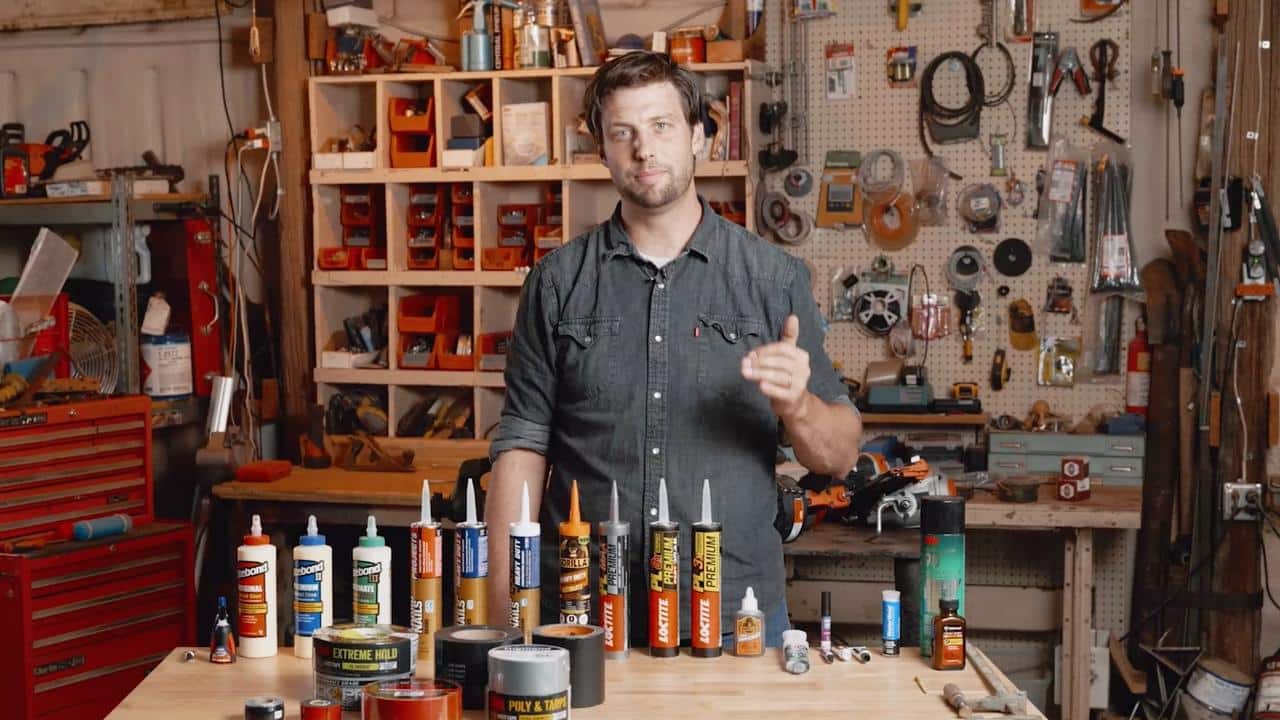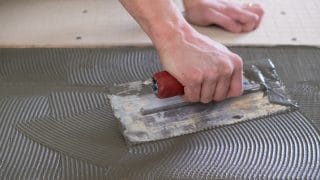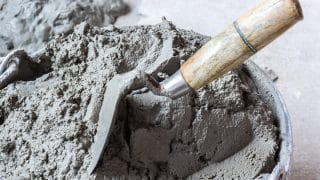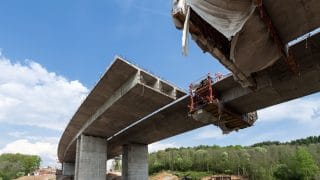
Versatile, long-lasting, and with a remarkable degree of heat resistance, epoxy adhesives can be used in almost any situation where you need to glue two materials together—think: binding sub floors, gluing a detail to a larger structure, or reinforcing a fastener. They can be used with a wide range of materials: wood, metal, plastic, masonry, and more. Read on to learn what epoxies are and why they play an essential role in construction.
What Is Epoxy?
Epoxy is a type of polymer, a group of chemical compounds that consist of large molecules with repeating subunits. The molecular structure of polymers give them their toughness and elasticity, making polymers (both natural and manmade ones) ubiquitous in daily life. Wool, rubber, Styrofoam, and epoxy are just a few of the polymers that you likely already know.
Epoxy resins include epoxides—highly reactive groups of molecules—that harden (or cure) through chemical reactions, which are caused either by combining it with other substances or heating it to a high temperature. This is the process through which an epoxy becomes “cross linked,” as polymer strands form into a hardened structure.
Two Types of Epoxy Adhesives
There are two main types of epoxy adhesives, one-part (or heat-cured) and two-part epoxies. One-part epoxies cure faster, though they are often not as strong as two-part epoxies.
1. Heat-Cured Epoxies
Heat-cured epoxies have many industrial applications, but are not often used in construction, due to the high-heat requirement for them to cure—even those that react at the lowest level of heat will need to be exposed to temperatures of at least 200 degrees Fahrenheit.
With its remarkable resilience, epoxy resin is used in products ranging from electronic components and medical devices to infrared telescopes and missile warning systems.
2. Two-Part Epoxies
With two-part epoxies, the two components needed to create the chemical reaction are packaged separately. When the resin (often called the “steel”) is mixed with the hardener, the result will, over the course of up to 24 hours, transform from a thick liquid to a putty and eventually a fully cured and hardened material. (To remove epoxy after it has set, you’ll need to scrape it off, first softening it with alcohol or paint thinner if necessary.)
Like their heat-cured counterparts, two-part epoxies have many industrial uses, in automotive, aeronautical, and other manufacturing areas, and they are also especially common in boat building. They are also used in construction projects, with applications including attaching countertops to substrates, fastening concrete elements to others either also of concrete or of stone or metal, and securing decorative moldings in place.
“J-B Weld definitely dominates the market in two-party epoxies in big-box stores,” professional builder Jordan Smith notes. J-B Weld and competitors sell two-part epoxy systems in many different systems from simple tubes that require manually mixing the components to cartridges for specialized guns.
Why don’t structures fall down or come apart? Learn all about the stuff that holds building materials together in the MT Copeland online Fasteners and Adhesives course. Taught by professional builder Jordan Smith, the course covers topics ranging from nails and screws to glues and epoxies.
How to Choose An Epoxy Adhesive
Measuring Strength
Epoxy packaging typically describes its content’s compressive, flexural, and tensile strengths in terms of the pounds per square inch (psi) it can withstand. Increased strength in one area often comes at the expense of another measure.
Consider your priorities when selecting an epoxy:
- If you’re most concerned with direct compressive resistance—that is, how much pressure the epoxy could resist when being compressed from both ends—pay attention to compressive strength. (The test for this consists of squeezing the epoxy from both top and bottom and seeing how many pounds of pressure per square inch it can bear before failing.)
- If you’re most concerned that the bonded materials be able to bend without breaking, pay more attention to flexural strength.
- If you’re most concerned that the bonded materials cannot be pulled apart, focus on tensile strength.
Curing Times
The periods of time required for curing vary among two-part epoxies. Also known as its “pot life” or “work time,” this is how long it takes for the adhesive to harden. For small projects, a short pot life is normally fine. For ones that require more precision and when you may need to make adjustments, you’ll want a longer work time which also gives you more time to clean up any mistakes. Stronger epoxies typically take longer to cure.
Viscosity
The viscosity of a material is, in Jordan Smith’s words, a measure of how “flowy” it is. Water has high viscosity; molasses has low viscosity. If you are concerned that the adhesive may drip while it is setting, you’ll want one with a high viscosity—that is, not too flowy.
Versatile, long-lasting, and with a remarkable degree of heat resistance, epoxy adhesives can be used in almost any situation where you need to glue two materials together—think: binding sub floors, gluing a detail to a larger structure, or reinforcing a fastener. They can be used with a wide range of materials: wood, metal, plastic, masonry, and more. Read on to learn what epoxies are and why they play an essential role in construction.
What Is Epoxy?
Epoxy is a type of polymer, a group of chemical compounds that consist of large molecules with repeating subunits. The molecular structure of polymers give them their toughness and elasticity, making polymers (both natural and manmade ones) ubiquitous in daily life. Wool, rubber, Styrofoam, and epoxy are just a few of the polymers that you likely already know.
Epoxy resins include epoxides—highly reactive groups of molecules—that harden (or cure) through chemical reactions, which are caused either by combining it with other substances or heating it to a high temperature. This is the process through which an epoxy becomes “cross linked,” as polymer strands form into a hardened structure.
Two Types of Epoxy Adhesives
There are two main types of epoxy adhesives, one-part (or heat-cured) and two-part epoxies. One-part epoxies cure faster, though they are often not as strong as two-part epoxies.
1. Heat-Cured Epoxies
Heat-cured epoxies have many industrial applications, but are not often used in construction, due to the high-heat requirement for them to cure—even those that react at the lowest level of heat will need to be exposed to temperatures of at least 200 degrees Fahrenheit.
With its remarkable resilience, epoxy resin is used in products ranging from electronic components and medical devices to infrared telescopes and missile warning systems.
2. Two-Part Epoxies
With two-part epoxies, the two components needed to create the chemical reaction are packaged separately. When the resin (often called the “steel”) is mixed with the hardener, the result will, over the course of up to 24 hours, transform from a thick liquid to a putty and eventually a fully cured and hardened material. (To remove epoxy after it has set, you’ll need to scrape it off, first softening it with alcohol or paint thinner if necessary.)
Like their heat-cured counterparts, two-part epoxies have many industrial uses, in automotive, aeronautical, and other manufacturing areas, and they are also especially common in boat building. They are also used in construction projects, with applications including attaching countertops to substrates, fastening concrete elements to others either also of concrete or of stone or metal, and securing decorative moldings in place.
“J-B Weld definitely dominates the market in two-party epoxies in big-box stores,” professional builder Jordan Smith notes. J-B Weld and competitors sell two-part epoxy systems in many different systems from simple tubes that require manually mixing the components to cartridges for specialized guns.
Why don’t structures fall down or come apart? Learn all about the stuff that holds building materials together in the MT Copeland online Fasteners and Adhesives course. Taught by professional builder Jordan Smith, the course covers topics ranging from nails and screws to glues and epoxies.
How to Choose An Epoxy Adhesive
Measuring Strength
Epoxy packaging typically describes its content’s compressive, flexural, and tensile strengths in terms of the pounds per square inch (psi) it can withstand. Increased strength in one area often comes at the expense of another measure.
Consider your priorities when selecting an epoxy:
- If you’re most concerned with direct compressive resistance—that is, how much pressure the epoxy could resist when being compressed from both ends—pay attention to compressive strength. (The test for this consists of squeezing the epoxy from both top and bottom and seeing how many pounds of pressure per square inch it can bear before failing.)
- If you’re most concerned that the bonded materials be able to bend without breaking, pay more attention to flexural strength.
- If you’re most concerned that the bonded materials cannot be pulled apart, focus on tensile strength.
Curing Times
The periods of time required for curing vary among two-part epoxies. Also known as its “pot life” or “work time,” this is how long it takes for the adhesive to harden. For small projects, a short pot life is normally fine. For ones that require more precision and when you may need to make adjustments, you’ll want a longer work time which also gives you more time to clean up any mistakes. Stronger epoxies typically take longer to cure.
Viscosity
The viscosity of a material is, in Jordan Smith’s words, a measure of how “flowy” it is. Water has high viscosity; molasses has low viscosity. If you are concerned that the adhesive may drip while it is setting, you’ll want one with a high viscosity—that is, not too flowy.
Water Resistance
Most epoxies are waterproof when hardened, but some are specifically designed so that they can cure even when exposed to water. If you are working on repairing a hole to a tank or a leaky connection between pipes, choose an adhesive designed for the task like J-B Weld’s WaterWeld.
3 Alternatives to Epoxy Adhesives
Epoxies can be used to bind together many different materials and fill in holes from natural defects in wood to small scratches or chips. There are some alternatives, however, that you may want to consider either because other adhesives work better with particular materials or if you want something that is easier to work with than an epoxy system.
1. Contact Cement
This is a neoprene rubber adhesive that can be used as a general adhesive but is especially effective when fastening two nonporous materials together. Epoxies typically need to air dry, meaning they are often not the best choice if you are, for example, gluing a laminate onto a countertop. Once the laminate is in place, air won’t be able to reach the adhesive.
2. Epoxy Putty
Instead of two different liquids, epoxy putty embeds the components in two different colors of putty. Slice off a portion, knead the putty until it is one consistent color, and then use it to make small repairs, such as cracks in pipes, holes in damaged woodwork, or chips in concrete. While epoxy putty is incredibly strong (and expensive), it is not intended for structural use as its tensile strength of around 900 psi is only a fraction of that of epoxy resin, which is typically in the 5,000 to 8,000 range.
3. Super Glue
This is a brand name for cyanoacrylate (also marketed as Krazy Glue). While it is a very strong glue, it doesn’t compare to epoxy resin and is best for small repairs of two pieces that fit together exactly. Its advantage is its ease of use, but to create a bond with serious structural strength, a heavy duty adhesive is the better option.
Pros and Cons of Epoxy Adhesives
Epoxies are one of many options when it comes to adhesives, though its strengths make it a popular choice in construction projects.
Advantages of Epoxy Adhesives:
- Strength: The polymeric structure of epoxies creates a remarkable strong bond, and one that is waterproof and able to withstand high temperatures.
- Compatibility: Epoxy can work to bind a broad array of different materials while other common adhesives are more limited in their use. For example, polyvinyl acetate glues require porous surfaces while epoxy resins offer greater flexibility.
- Speed: The curing time varies for epoxies, but for some fast-acting ones it can be under an hour for a functional cure (when it is at roughly 60 percent of its final, fully cured strength).
Disadvantages of Epoxy Adhesives:
- Complicated Application: Two-part epoxies require combining two different substances, either by hand or through an application system. In many situations it is easier to reach for a bottle of wood glue or Super Glue, and the resulting bond will be sufficiently strong.
- Ventilated Spaces: Epoxy fumes are hazardous and you’ll want to limit their use to well ventilated spaces. Also many epoxies perform best when applied to air dry surfaces.
Epoxy Coatings and Sealants
Epoxy’s special adhesive properties—its durability, strength, and chemical resistance—also make it a tough protective coating or sealant. When the components are mixed together and sprayed over materials such as concrete or wood, it will resist abrasions as well as oil and other liquids. High performance epoxy resins dry with a clear (cloudless) finish.
Note: If you install an epoxy coating, you’ll want to keep an eye open for air bubbles that can form as the concrete off gases—a porcupine roller is an effective tool for eliminating them.
Other Uses
Epoxy Floors
Epoxy floor coatings and epoxy floors are two different treatments with confusingly similar names. While an epoxy floor coating is a relatively thin layer of epoxy, an epoxy floor consists of a thicker (at least two millimeters) layer of epoxy that creates an unbroken, glossy surface that can be installed in a variety of colors. They tend to be more common in commercial than residential construction as their durability in high-traffic conditions justifies the extra expense.
Epoxy Paint or Acrylic Sealers
Epoxy paint also has a name that may be misleading. Unlike an epoxy coating, an epoxy paint (or acrylic sealer) is an acrylic paint with a small amount of epoxy. It is more durable than standard acrylic paint, but it does not have the same strength as a true epoxy coating. It is, however, less expensive and dries faster.
MT Copeland offers video-based online classes that give you a foundation in construction fundamentals with real-world applications. Classes include professionally produced videos taught by practicing craftspeople, and supplementary downloads like quizzes, blueprints, and other materials to help you master the skills.







